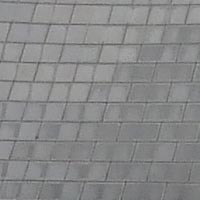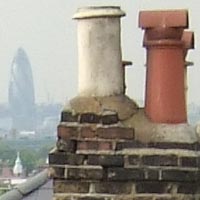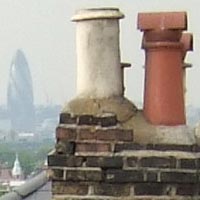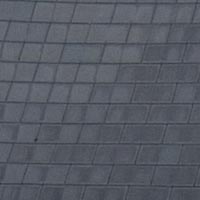Fujifilm Finepix E900 Review
Review Date: May 19th 2006
Leave a Comment about this Review
|
Image Quality
All of the sample images in this Review were taken using the 9M Fine quality mode, which gives an average image size of around 4Mb - 5Mb.
Noise
There are 5 ISO settings available on the Fujifilm Finepix E900 which you can select at any time if the camera is in any shooting mode. Here are some 100% crops which show the noise levels for each ISO setting:
ISO 80 (100% crop) |
ISO 100 (100% crop) |
 |
 |
ISO 200 (100% crop) |
ISO 400 (100% crop) |
 |
 |
ISO 800 (100% crop) |
|
 |
|
The slowest settings of ISO 80 and 100 don't have any discernible noise. ISO 200 shows a little noise and a very slight softening of detail. At ISO 400 there's more noise and blurred detail, but it's still a very usable speed. ISO 800 has pretty obvious noise and loss of detail, but the overall effect is actually quite pleasant and I wouldn't hesitate to use it if there wasn't any other alternative. Overall an excellent performance by the E900.
Sharpening
Here are two 100% crops which have been Saved as Web - Quality 50 in Photoshop. The right-hand image has had some sharpening applied in Photoshop. The out-of-the camera images are soft at the default sharpening setting of Standard and benefit from some further sharpening in a program like Adobe Photoshop. Alternatively you can change the in-camera sharpening level to Hard, Standard or Soft to suit your taste.
Original
100% Crop |
Sharpened 100% Crop |
 |
 |
 |
 |
File Quality
The Fujifilm Finepix E900 has 2 different file quality settings available, with Fine being the highest quality option. Here are some 100% crops which show the quality of the various options, with the file size shown in brackets.
| 9M
Fine (4.49Mb) |
9M
Normal (2.18Mb) |
 |
 |
RAW Format
The Fujifilm Finepix E900 has offers RAW format as well as JPEG files. Unfortunately the software supplied with the camera only allows you to do a straight conversion from RAW to TIFF, without being able to adjust the white balance, exposure or other parameters, which is the main benefit of shooting in RAW. The E900's .RAF files are recognised by the latest version of Adobe Camera RAW, though, so if you have Adobe Photoshop CS2 you will be able to alter the RAW file and save it as a JPEG or other file format. Here are some 100% crops which show the quality of the RAW file after conversion to a JPEG in Adobe Camera RAW.
| 9M
RAW (click to view full-sized image) |
100%
Crop |
Chromatic Aberrations
The Fujifilm Finepix E900 handled chromatic aberrations very well during the review, with only limited purple fringing present around the edges of objects in certain high-contrast situations, as shown in the examples below.
| Example
1 (100% crop) |
Example
2 (100% crop) |
 |
 |
Macro
The Fujifilm Finepix E900 offers a Macro setting that allows you to focus on a subject that is 7.5cms away from the camera when the lens is set to 38mm wide-angle. The first image shows how close you can get to the subject (in this case a compact flash card). The second image is a 100% crop.
| Macro Shot (click to view full-sized image) |
100% Crop |
Flash
The flash settings on the Fujifilm Finepix E900 are Auto, Red-eye Reduction, Forced Flash, Suppressed Flash, Slow Synchro., Red-eye Reduction + Slow Synchro.. These shots of a magnolia coloured wall were taken at a distance of 1.5m.
| Flash Off - Wide Angle (32mm) |
Auto Flash - Wide Angle (32mm) |
 |
 |
| Flash Off - Telephoto (128mm) |
Auto Flash - Telephoto (128mm) |
 |
 |
And here are some shots of yours truly. Both the Auto or the Digital Red-Eye Reduction option caused a small amount of red-eye, and the overall exposure is perhaps slightly over-exposed.
| Flash On |
Flash On (100% Crop) |
 |
 |
| Flash - Red-Eye Reduction |
Flash - Red-Eye Reduction (100% Crop) |
 |
 |
Night Shot
The Fujifilm Finepix E900 maximum shutter speed is 15 seconds in the Manual exposure mode, which is fine for night photography. The shot below was taken using a shutter speed of 15 seconds at f5.6 at ISO 80. I've included a 100% crop of the image to show what the quality is like.
| Night Shot (click to view full-sized image) |
100% Crop |
 |
|
Overall Image Quality
The Fujifilm Finepix E900 produced images of excellent quality during the review period. The 9 megapixel images were quite soft straight out of the camera at the default sharpening setting and ideally require some further sharpening in an application like Adobe Photoshop, or you should change the in-camera setting to Hard. The Fujifilm Finepix E900 dealt very well with chromatic aberrations, with limited purple fringing effects appearing only in high contrast situations. Macro performance is slightly below average, allowing you to focus as close as 7.5 cms away from the subject. The RAW format is only worth using if you own Adobe Photoshop CS2, as the supplied software only allows you to save as a TIFF with no image adjustments. The built-in flash worked fairly well indoors, with a small amount of red-eye and slight over-exposure. The night photograph was very good, with the maximum shutter speed of 15 seconds long enough for most situations. The 1/1.6 inch, 9 megapixel sensor used in the Fujifilm Finepix E900 was fine at ISO 80-200, good at ISO 400 and still usable at the fastest speed of ISO 800, a very good performance for a compact digicam.
|
![]() PhotographyBLOG
is a member of the DIWA
organisation. Our test results for the Fujifilm Finepix E900
have been submitted to DIWA
for comparison with test results for different samples of
the same camera model supplied by other DIWA
member sites.
PhotographyBLOG
is a member of the DIWA
organisation. Our test results for the Fujifilm Finepix E900
have been submitted to DIWA
for comparison with test results for different samples of
the same camera model supplied by other DIWA
member sites.





